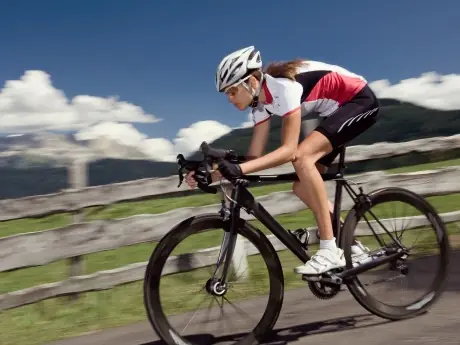
I learned how to ride a bike in the mid-1970s back when people didn't wear seatbelts, smoked in airplanes and bought non-organic produce. Needless to say, helmets weren't exactly "a thing." One day in my late 30s I decided I wanted to train for a triathlon. Until that day, I'd never owned a single bike helmet. Being new to the sport, my knowledge was limited. And my financial resources were stretched to the point of marital meltdown. These factors, combined with a disproportionally small head, led me to the local hardware store, where I purchased a helmet best suited for a 12-year-old skateboarder.
Here are five important basics that will hopefully save you from a similar fate.
1) Function
Don't go to a gunfight with a spatula.
There is a big difference between riding to the corner store on your beach cruiser and racing a criterium, so you need to select your helmet accordingly. A good, all-purpose bike helmet can be used for most cycling activities, so there is rarely the need to be the Imelda Marcos of cycling headgear—but there are several categories of cycling helmets you'll want to be familiar with:
Road Helmets
Generally lighter and more compact, these helmets are more aerodynamic than mountain bike helmets and have plenty of venting to keep you cool. However, the lighter and more aerodynamic the helmet is, the pricier it gets. That's because of all the engineering it takes to make something that weighs less than a piece of toast but still protects your brain if things go sideways. A visor has no business on a road helmet, so if yours came with one, take it off—like right now.
Mountain Bike Helmets
These helmets have more coverage in the back and sides and less venting because nature (although nice to look at) doesn't always provide a friendly landing. Visors are favored by mountain bikers over sunglasses for better visibility on shaded trails, plus it ensures they won't be mistaken for a silly roadie.
Time Trial and Triathlon Helmets
Built entirely for aerodynamics, these helmets are shaped to cut through the air at high speeds. You can always distinguish them from other helmets because they tend to look completely ridiculous. Rounded at the front and sometimes with a face shield with a long pointy back, put one of these numbers on and you will immediately look like the thing from "Alien." That said, dollar for dollar, they offer the biggest bang for the buck in shaving time off your TT. If you're lucky, at least once in your life you will see a newbie wear it backwards. Don't be that guy.
Urban/Commuter Helmets
You can use a road or mountain bike helmet for the purposes of commuting or buzzing around town, but a commuter style typically has more coverage to protect you from the elements. Plus, they have real style. Many come in bright colors and with reflective details to make you more visible in traffic (or at least less invisible) in low light or rainy conditions. Urban lids (the kind skaters and BMX riders wear) feature rad colors and designs but have very little ventilation. They are a perfect pick for trick riding and hanging out, but will cook your head like an egg if you wear it on a long, hard ride.
2) Cost
Invest in Your Head
Your expensive disc wheels can be replaced—your brain can't. If you can afford a $5,000 bike, you can certainly spend good money to protect your head, so buy the best one your budget allows. You don't need to spend a fortune to get a good quality helmet that is safety certified, comfortable and that fits you—and really beyond that it's all bells and whistles.
Remember my hardware store helmet? It cost me $30, but it was certified, safe and perfect for doing BMX tricks at the local skate park. It may not have been popular with the gear snobs, but as a newbie, I had bigger things to worry about than meeting the approval of the fashion police—like staying upright on my clipless pedals, for example. Many years, miles and several crashes later, I spend as much as humanly possible on a helmet because, although some might argue otherwise, I think my head is worth it. A $400 helmet doesn't guarantee my safety by any means, but it does helps me feel like I've done the best I can to protect myself in the event of a crash or collision. Plus, it looks so freaking pro.
- 1
- of
- 2









Discuss This Article